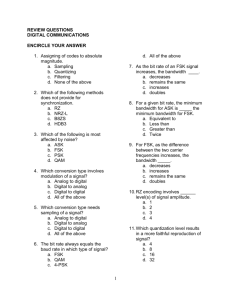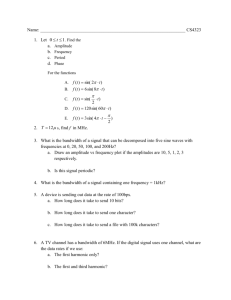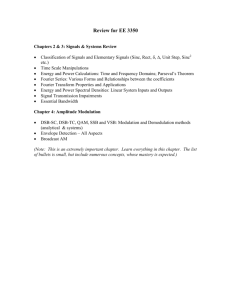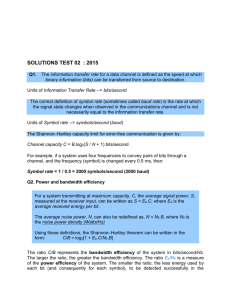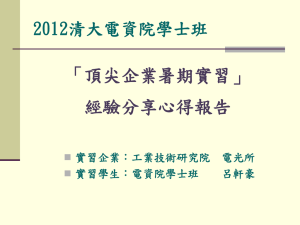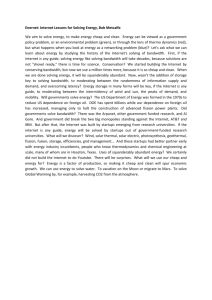Digital Communications
advertisement
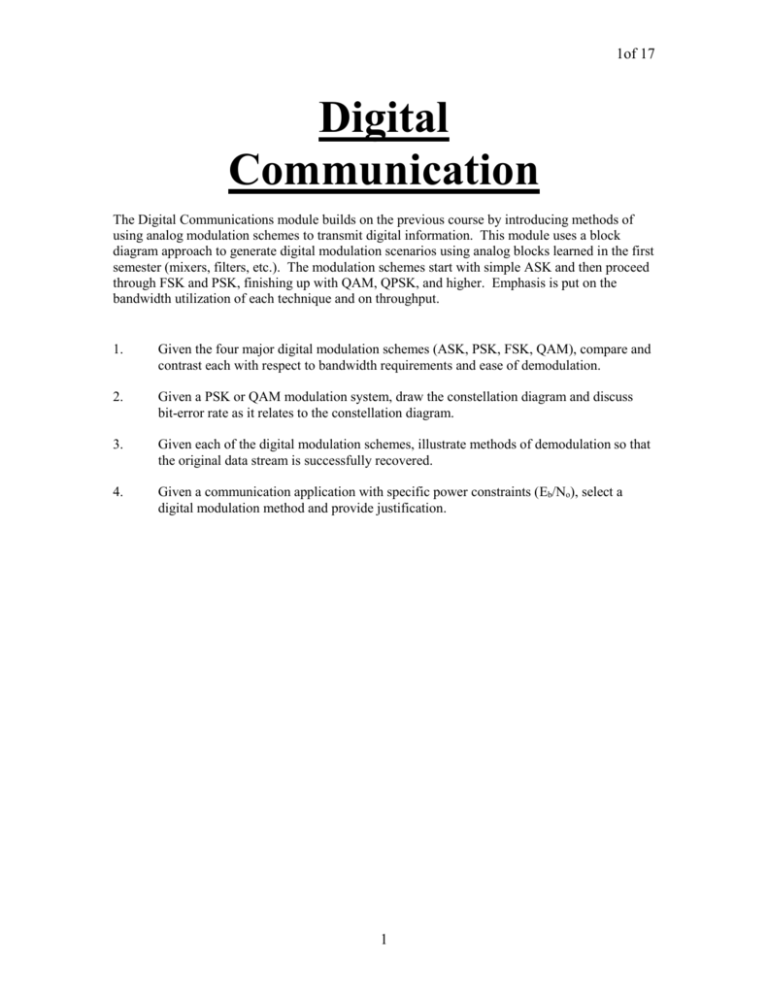
1of 17 Digital Communication The Digital Communications module builds on the previous course by introducing methods of using analog modulation schemes to transmit digital information. This module uses a block diagram approach to generate digital modulation scenarios using analog blocks learned in the first semester (mixers, filters, etc.). The modulation schemes start with simple ASK and then proceed through FSK and PSK, finishing up with QAM, QPSK, and higher. Emphasis is put on the bandwidth utilization of each technique and on throughput. 1. Given the four major digital modulation schemes (ASK, PSK, FSK, QAM), compare and contrast each with respect to bandwidth requirements and ease of demodulation. 2. Given a PSK or QAM modulation system, draw the constellation diagram and discuss bit-error rate as it relates to the constellation diagram. 3. Given each of the digital modulation schemes, illustrate methods of demodulation so that the original data stream is successfully recovered. 4. Given a communication application with specific power constraints (Eb/No), select a digital modulation method and provide justification. 1 2of 17 TABLE OF CONTENTS 1. 2. 3. Classification of Communication Systems ............................................................. 3 Bandwidth Considerations ...................................................................................... 4 Information Capacity .............................................................................................. 5 4. Digital Modulation .................................................................................................. 9 ASK................................................................................................................... 9 FSK ................................................................................................................. 10 PSK ................................................................................................................. 12 QPSK .............................................................................................................. 12 MPSK.............................................................................................................. 14 Noise and Error Rate Performance ....................................................................... 17 5. 2 3of 17 CLASSIFICATION OF COMMUNICATION SYSTEMS Analog modulating Waveform AM, FM, PM Analog modulating Waveform Digital modulating Waveform Analog Modulated Waveform Digital Modulated Waveform PCM ASK, FSK, PSK 3 Analog modulated Waveform 4of 17 BANDWIDTH CONSIDERATIONS Rectangular (NRZ) Rectangular bipolar(RZ) Raised cosine Transmission systems are designed to use pulses whose shapes maximize the percentage of total signal power within the first 'lobe' of the spectrum. For a channel with a bandwidth whide enough to include the first lobe, transmitting raised cosine pulses result in the reception of more power with less pulse distortion than for rectangular pulses. 4 5of 17 CHANNEL CAPACITY OF A WHITE ADDITIVE GAUSSIAN NOISE CHANNEL Hartley Law C B T where C=information capacity B=bandwidth T=transmission time Shannon's limit for Information Capacity (also known as Shannon-Hartley law): S S C 2 B log 2 M 2 B log 2 1 B log 2 1 N N S 3.32 B log 10 1 N Cc = Capacity in bps B = Channel Bandwidth in Hz S = Ratio of Signal Power to Noise power. N The above equation is also referred to as the Shannon-Hartley law. 5 6of 17 Example Determine the channel capacity if the SNR is 20 dB, and the bandwidth available is 4 kHz (Appropriate for telephone communications) Solution 10 C 4 log2 1 10 4 log2 101 20 26.63kbits / sec value of 100 is appropriate for an SNR of 20 dB. Example If it is required to transmit at 50 kbit/s, and a bandwidth of 1 MHz is used, determine the minimum SNR required. Solution 50 = 1000 log 2(1+S/N) C S 2 W 1 N 0.035 14.5dB This shows that in some sense it may be possible to transmit using signals below the noise level, using wide bandwidth communication, as in “spread spectrum” communications. Let Eb = Bit energy = STb = S/Rb N0 = Noise density = N/B Where Tb = Bit time And Rb = Bit rate 6 7of 17 Hence: E b SB N 0 N Rb S E b Rb E b C c N N0 B N0 B If bit rate Rb = CC, then S Eb Cc N N0 B The Shannon-Hartley law can then be expressed as: C c log 1 Eb C c 2 B N0 B B C E b 2 B 1 N 0 Cc c Now for B>>Cc c B 2 C e C c ln 2 B 1 C c ln 2 B and hence for B>>Cc 7 8of 17 E N b ln 2 1.6dB 0 This value is referred to as the Shannon Limit Example Telephony circuit using 3 kHz bandwidth and S/N=30 db. Using Shannons Law CC = 3103 log2(1+103) = 29.92 kb/s since 30 db = 103 For binary information, ie M=2, Shann-Hartley law gives for a noiseless channel CC = 23103 log2(2) = 23103 b/s = 6 kb/s The number of states required to approach Shannon limit 2B log2(M) = B log2(1+S/N) = 29.92 kb/s log2M = 29.92kbps/6k M = 31.6 32 states or 32 level code system can be used. Such a system can use PAM where each bit is assigned 1 of 32 possible levels or Using binary PCM will required 5 bits (25 = 32) but will take 5 times longer to get the information transferred through the 3kHz telephone line. 8 9of 17 DIGITAL MODULATION v(t)=V sin(2 f t + ) ASK FSK PSK QAM ASK v(t)=s(t)sin(2fct) s(t) is baseband signal fc is the carrier frequency Frequency Spectrum ASK is rarely used in wireless applications, since noise and multipath effects can adversely affect the amplitude, causing great errors on decoding. FSK and PSK are more robuse in the presence of multipath. Hybrid forms of ASK PSK or FSK exist. For ASK, bandwidth = baud rate Digital Baseband modulating signal fm ASK Modulated Signal fc 2fm 9 10of 17 LPF Sample & Hold Threshold Comparison cos( t) Receiver Block Diagram FSK v(t)=sin(2f1t) for bit 1 v(t)=sin(2f2t) for bit 0 The carrier frequencies are usually picked to be orthogonal to each other (ie The minimum frequency spacing f=1/Tb where Tb is the bit period. 10 11of 17 Frequency Modulator BPF Envelope Detector BPF Envelope Detector Data Output BPF noise Transmitter --- channel --- Receiver Block Diagram FSK Bandwidth = baud rate + frequency shift for BFSK, baud rate = bit rate Bandwidth of FSK Signal BW=(f2-f1)+2fm where BW is the total signal bandwidth f2 and f1 are the mark and space frequencies fm is the bandwidth of base signal This is illustrated with the diagram as follow: Digital Baseband modulating signal fm f1 2fm f2 FSK Modulated Signal 11 12of 17 The minimum bandwidth occurs when the two "humps" touch each other. BWmin = 4fm PSK v(t)=sin(2ft) for bit 1 v(t)=sin(2ft+) for bit 0 This is called BPSK as there are two phases 0 and representing 0 and 1. See illustration for the waveform. QPSK s1(t)=sin(2ft - ) for bits 01 s2(t)=sin(2ft - 3) for bits 00 s3(t)=sin(2ft + 3) for bits 10 s4(t)=sin(2ft + ) for bits 11 12 13of 17 See illustration for the waveform. Constellation Diagram Block Diagram of Transmitter 13 14of 17 Block Diagram of Receiver LPF BP Filter Power Splitter Carrier Recovery series to parallel conversion 90 deg LPF MPSK for symbols s1-sM 14 15of 17 QAM s1(t) = 1.848sin(2ft - 3/4) for bits 001 s2(t) = 0.765sin(2ft - 3) for bits 000 s3(t) = 0.765sin(2ft - ) for bits 010 s4(t) = 1.848sin(2ft - ) for bits 011 s5(t) = 1.848sin(2ft + 3) for bits 101 s6(t) = 0.765sin(2ft + 3) for bits 100 s7(t) = 0.765sin(2ft + ) for bits 110 s8(t) = 1.848sin(2ft + ) for bits 111 Waveform 15 16of 17 Constellations 8 QAM Encoder Block Diagram 16 17of 17 Noise and Error Rate Performance The Basic SNR Parameter for Digital Communication Systems. In Digital System Eb/No, a normalized version of SNR is used. Eb = Bit energy = STb =S/Rb where Rb is bit rate, S is signal power, Tb is bit time No = noise power spectral density = N/W where W is bandwidth, N is noise power Eb/No=STb/N/W=S/Rb/NW=S/N(W/R) One important metric is plot of bit error probability PB vs Eb/No. This is a 'water-falllike' shape. PB Eb/No For a given probability of error, the smaller the required Eb/No, the more efficient is the detection process. 17
